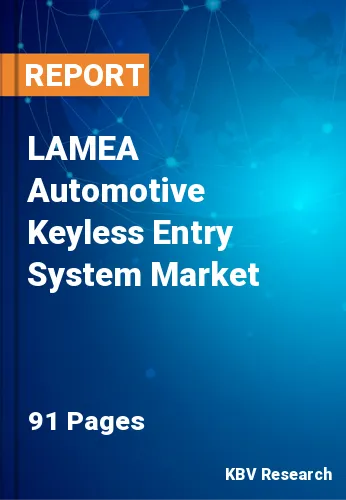The Latin America, Middle East and Africa Automotive Keyless Entry System Market would witness market growth of 13.1% CAGR during the forecast period (2022-2028).
The receiver detects the radio signal and verifies that the device is connected to the network by checking the device address. If that's the case, it decodes the message using the relevant secret symmetrical cryptographic keys from a table. The decryption is verified by comparing the encrypted address and control data to the plain text fields. Each transmitter in the system has a copy of the latest received synchronization counter state saved in the receiver. The message is regarded as genuine and the instruction is performed out if the current counter state is higher than the previous one up to a predetermined number of additions above the last one obtained, the acceptance zone.
These days, keyless entry remote devices, often known as key fobs, are widely used. It enables the driver to perform functions similar to a traditional car key without having to physically handle the vehicle. Even if an individual is inside a structure, the person can lock or unlock the power door locks from a distance of several feet. A driver can also start a car without placing the metal key into the ignition's keyway. To use this automobile technology, an individual requires keyless entry programming that's compatible with the vehicle.
The Dubai government is currently considering to improve the cyber-security of intelligent and autonomous vehicles. The campaign was started in response to numerous theft incidents regionally in which vehicles were robbed even in daylights. In order to allow and secure these developing technologies against any problems, regional automotive manufacturers have carefully worked with its government partners to define the best practices and standards to be implemented. Hence with these good initiatives, the regional vehicle owners can peacefully park the vehicle anywhere, whether the vehicle is close to the range or not without having any sort of fear that the vehicle will get robbed in the absence of the car owner. Therefore, due to enhanced automotive keyless services provided in the region, the regional automotive keyless entry system market is expected to grow in the forecast period.
The Brazil market dominated the LAMEA Automotive Keyless Entry System Market by Country in 2021, and would continue to be a dominant market till 2028; thereby, achieving a market value of $64.3 Million by 2028. The Argentina market is anticipated to grow at a CAGR of 13.7% during (2022 - 2028). Additionally, The UAE market would showcase a CAGR of 12.8% during (2022 - 2028).
Based on Product Type, the market is segmented into Remote Keyless Entry (RKE) System and Passive Keyless Entry (PKE) System. Based on Sales Channel, the market is segmented into OEM and Aftermarket. Based on Vehicle Type, the market is segmented into Passenger Cars, LCV, and HCV. Based on countries, the market is segmented into Brazil, Argentina, UAE, Saudi Arabia, South Africa, Nigeria, and Rest of LAMEA.
Free Valuable Insights: The Global Automotive Keyless Entry System Market is Predict to reach $3.1 Billion by 2028, at a CAGR of 11.4%
The market research report covers the analysis of key stake holders of the market. Key companies profiled in the report include Continental AG, Denso Corporation, Valeo SA, Mitsubishi Electric Corporation, Robert Bosch GmbH, NXP Semiconductors N.V., HELLA GmbH & Co. KGaA, Alps Alpine Co., Ltd., Microchip Technology, Inc., and Tokai Rika Co., Ltd.
By Product Type
By Sales Channel
By Vehicle Type
By Country
Our team of dedicated experts can provide you with attractive expansion opportunities for your business.

